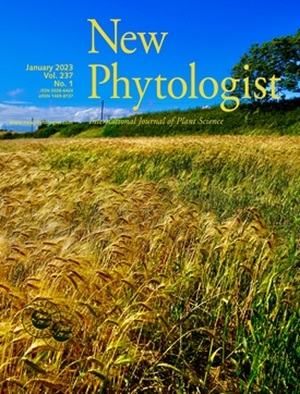根系可塑性的微生物驱动因素
IF 8.3
1区 生物学
Q1 PLANT SCIENCES
引用次数: 0
摘要
土壤是一个高度不均匀和动态的系统,经历植物根系分泌物的持续流动和水分波动,影响养分分布、土壤理化性质和微生物代谢。植物根系通过综合当地环境条件和生理信息信号来调节其在土壤基质中的发育(生长、分支、根角和解剖特征)。这些生理反应和根系的适应性通常被定义为可塑性。虽然是遗传决定的,但根的可塑性受到当地水分和养分可用性波动、环境变化、土壤性质以及与根相关的微生物群的调节。根及其附近是由分类和功能不同的微生物物种定殖的。这些群落中的特定成员可以通过根源信号与植物建立化学通讯,从而利用植物的激素和发育网络,影响根的可塑性。鉴于大多数与可塑性相关的根系性状都是在无菌条件下发现的,我们对根系相关微生物群成员调节根系塑性反应的多种潜在机制的了解仍然有限。在这篇综述中,我们探讨了这一领域的最新进展,并确定了未来研究的具体途径,以推进微生物介导的陆地系统根系可塑性的分子和生态理解。本文章由计算机程序翻译,如有差异,请以英文原文为准。
Microbial drivers of root plasticity
SummarySoils are highly heterogeneous and dynamic systems, experiencing a constant flow of plant root exudates and moisture fluctuations that affect nutrient distribution, soil physicochemical properties, and microbial metabolisms. Plant roots adjust their development within the soil matrix (growth, branching, root angle, and anatomical features) by integrating local environmental conditions with physiologically informed signals. These physiological responses and the adaptability of roots are commonly defined as plasticity. Although genetically determined, root plasticity is modulated by local fluctuations in water and nutrient availability, environmental changes, and soil properties as well as by the root‐associated microbiota. Roots and their vicinity are colonized by taxonomically and functionally diverse microbial species. Specific members within these communities can establish chemical communication with plants via root‐derived signals, thereby tapping into the plant's hormonal and developmental network, influencing root plasticity. Given that most root traits associated with plasticity have been discovered under axenic conditions, our knowledge of the multiple potential mechanisms by which members of the root‐associated microbiota modulate root plastic responses is still limited. In this review, we explore the recent progress in this field and identify specific avenues for future research toward advancing molecular and ecological understanding of microbial‐mediated root plasticity in terrestrial systems.
求助全文
通过发布文献求助,成功后即可免费获取论文全文。
去求助
来源期刊

New Phytologist
生物-植物科学
自引率
5.30%
发文量
728
期刊介绍:
New Phytologist is an international electronic journal published 24 times a year. It is owned by the New Phytologist Foundation, a non-profit-making charitable organization dedicated to promoting plant science. The journal publishes excellent, novel, rigorous, and timely research and scholarship in plant science and its applications. The articles cover topics in five sections: Physiology & Development, Environment, Interaction, Evolution, and Transformative Plant Biotechnology. These sections encompass intracellular processes, global environmental change, and encourage cross-disciplinary approaches. The journal recognizes the use of techniques from molecular and cell biology, functional genomics, modeling, and system-based approaches in plant science. Abstracting and Indexing Information for New Phytologist includes Academic Search, AgBiotech News & Information, Agroforestry Abstracts, Biochemistry & Biophysics Citation Index, Botanical Pesticides, CAB Abstracts®, Environment Index, Global Health, and Plant Breeding Abstracts, and others.
 求助内容:
求助内容: 应助结果提醒方式:
应助结果提醒方式:


